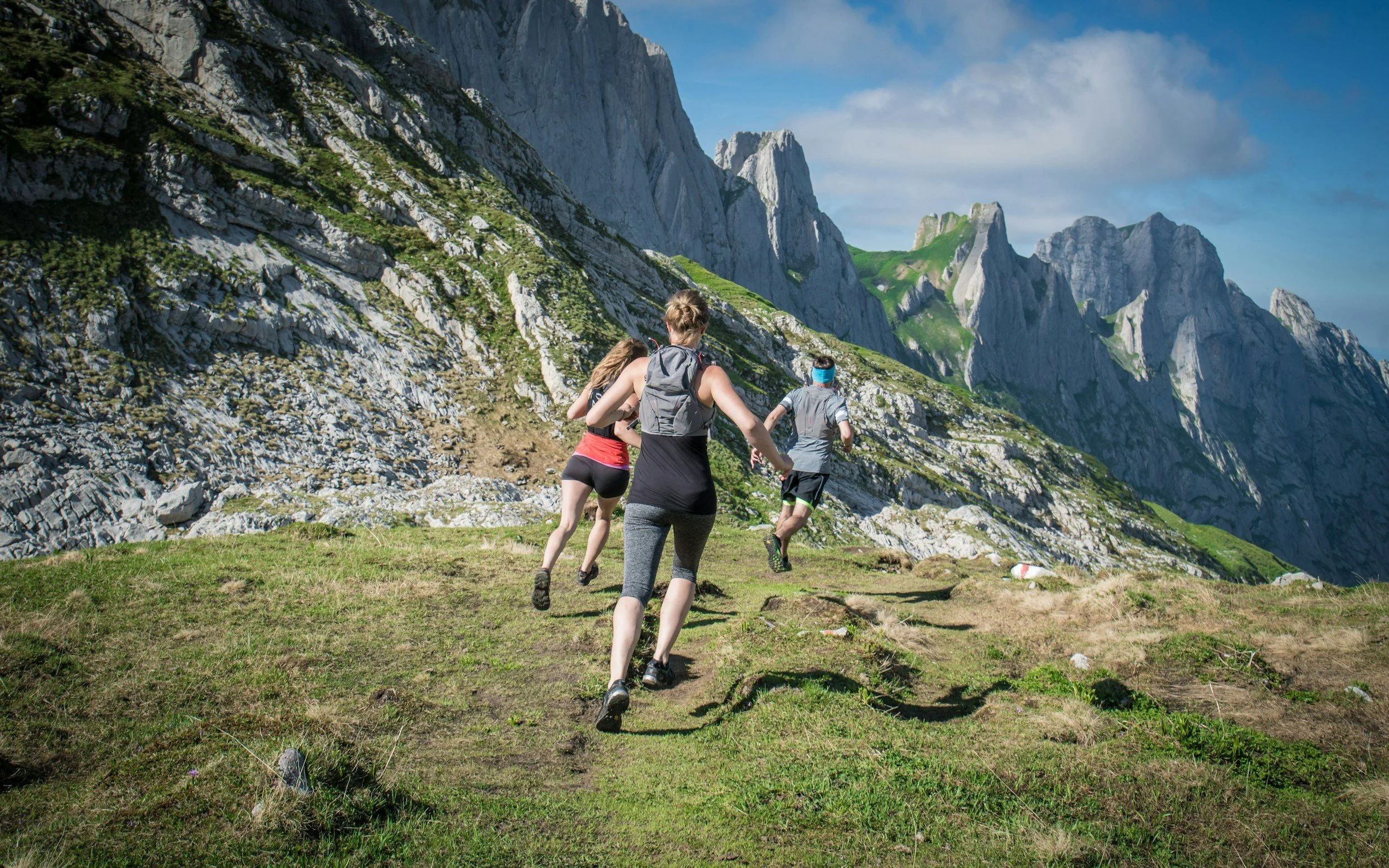Elevate Your Running Game: 7 Key Types of Runs for Better Training
Whether you're a seasoned runner or just lacing up your shoes for the first time, it's easy to fall into the trap of running the same route at the same pace every time. But here's the thing: mixing up your runs can take your fitness and speed to the next level! Different types of runs serve different purposes, so let’s break down some of the most popular ones and throw in some gear suggestions to make each one a little easier and more enjoyable.
*Please be aware that by clicking on some links, you may contribute a small commission to us as an affiliate, at no cost to you, which helps us continue providing valuable educational content for free! We appreciate your support, as it enables us to break down barriers and make outdoor education accessible to everyone. Rest assured that we only endorse gear that we personally love and would use ourselves. Thank you for being a part of our mission to empower outdoor enthusiasts worldwide!
Table of Contents
1. Fartlek Runs (The Fun Run!)
What is it?
Fartlek is all about mixing up your pace with intervals of fast sprints and easy jogs. The key is that it’s not structured—you can decide on the fly when to speed up and slow down based on how you feel or what’s around you (e.g., sprint to the next tree, jog to the next stop sign). You can also measure your intervals by time, like running fast for one minute followed by three minutes of easy effort, or by distance, such as a faster pace for half a mile, then an easy pace for half a mile. Fartlek gives you full control to adjust paces and intervals as you go.
Why do it?
This type of run helps improve both speed and endurance without the pressure of specific intervals.
Gear Tip:
A Garmin Forerunner 265 can help track your varying paces during a fartlek run. Plus, it allows you to check in on your heart rate and distance without breaking your flow.
2. Tempo Runs (The 'Get Comfortable Being Uncomfortable' Run)
What is it?
A tempo run involves running at a "comfortably hard" pace—faster than your easy jog but slower than an all-out sprint. It’s a challenging, steady pace that you can sustain for 20-40 minutes, typically about 20 to 45 seconds per mile slower than your 5K race pace. Think of it as finding the sweet spot between effort and exhaustion, a level of effort you could maintain for about an hour.
Why do it?
Tempo runs improve your lactate threshold, meaning you’ll get faster and be able to maintain that speed for longer.
Gear Tip:
The Topo Athletic FLI-Lyte 5 shoes are incredibly responsive, offering a light, natural feel. You'll appreciate the extra support and energy return they provide, especially when you're pushing through that comfortably hard pace on your tempo runs.
3. Hill Strides (The Lung Burners)
What is it?
Hill strides are short, fast sprints up an incline that combine the benefits of strides running—also called pick-ups or striders—with the added challenge of a hill. After warming up, find a hill and start with a controlled pace at the bottom. Gradually accelerate with each step, focusing on over-exaggerating your running form for optimal mechanics. As you reach top speed midway through the hill, maintain that pace to the top. Jog or walk back down to recover. Hill strides can be a stand-alone speed workout or added after easy runs to improve form and boost speed. Repeat based on your energy level and the incline of the hill.
Why do it?
This is fantastic for building strength and explosive power in your legs. Plus, it’s great for mental toughness!
Gear Tip:
The Salomon Active Skin 8 Hydration Vest is perfect if you’re tackling long hill workouts and need to carry water. The vest is lightweight and snug, so it won’t bounce around during those sprints.
4. Long Runs (The Time-on-Feet Run)
What is it?
A long run is exactly what it sounds like—a longer, slower-paced run designed to build endurance and improve your aerobic capacity. Typically, it’s the longest run of your week, and it’s essential for anyone training for distance events like a half-marathon or marathon. Unlike faster, high-intensity runs, the focus here is on time spent on your feet rather than speed, which helps your body adapt to sustained effort over time. Long runs train your muscles, joints, and cardiovascular system to handle the stress of prolonged activity, while also teaching you mental resilience. Depending on your training plan, these runs can range from an hour to several hours, gradually increasing as you prepare for race day.
Why do it?
Long runs increase your aerobic capacity and help your body adapt to sustained effort. They also give you mental prep for longer races.
Gear Tip:
A Garmin Fēnix 7S Pro Sapphire Solar will keep you on track with built-in maps for those long trail runs and customizable data screens to track pace, heart rate, and more.
5. Interval Runs (The Speed Demon)
What is it?
Intervals involve alternating between short, high-intensity efforts, like sprinting, and recovery periods, which can involve slow jogging or stopping completely. For example, you might sprint for 1 minute, then jog for 1 minute, repeating this cycle for 20-30 minutes. A typical interval workout could include 8 x 400m reps at your 5K pace, with recovery periods lasting as long as the rep itself. This combination of intense effort and recovery helps improve speed, endurance, and cardiovascular fitness.
Why do it?
These runs are excellent for increasing speed and cardiovascular fitness. Plus, the quick recovery periods give you just enough time to catch your breath and push harder on the next sprint.
Gear Tip:
A Polar Verity Sense Heart Rate Monitor is a great add-on for interval training. It keeps tabs on your heart rate so you can ensure you're hitting the right zones during the work and recovery phases.
6. Recovery Runs (The Chill Run)
What is it?
After a tough workout or race, a recovery run is all about giving your body a chance to shake off fatigue with a relaxed, low-intensity jog. The key is to keep the effort light and easy—this isn't about pushing your limits. In fact, it should feel almost effortless, with the goal being to get your blood flowing and loosen up your muscles without adding any extra strain. You should be able to hold a full conversation the entire time, meaning your breathing remains steady and controlled. Recovery runs help promote circulation, reduce muscle stiffness, and speed up the healing process, allowing you to stay active while giving your body a much-needed break from the intensity of harder workouts. Think of it as active recovery—keeping you moving, but in a way that feels restorative rather than exhausting.
Why do it?
Recovery runs keep blood flowing to sore muscles, helping them heal and flush out lactic acid. It’s also a great way to stay active without overtraining.
Gear Tip:
Wear some ALTRA Womens Via Olympus 2 for extra cushioning on those easy days. Your joints will thank you after a long week of running.
7. Progression Runs (The Negative Split)
What is it?
A progression run begins at a comfortable, easy pace and gradually increases in speed throughout the workout, culminating in a strong finish at your fastest pace. This type of run allows you to build confidence in your pacing strategy, as you learn to listen to your body and gauge your effort over time. Starting slow helps warm up your muscles and prepares your cardiovascular system for the increased intensity. As you progress, you can focus on maintaining good form and smooth transitions between paces, which is crucial during race conditions.
The goal is not just to run faster but to do so in a controlled manner, ensuring you still have enough energy to push through the final segment. Practicing progression runs can help you simulate the experience of a race, where pacing is essential to finishing strong. You’ll learn how to conserve energy early on, so you can kick it into high gear when it counts most. Additionally, these runs can enhance your mental toughness, teaching you to maintain focus and motivation even as fatigue sets in. Overall, progression runs are a powerful tool for building endurance, speed, and race-day confidence.
Why do it?
Progression runs teach your body how to conserve energy early on, so you can finish races feeling strong.
Gear Tip:
A Coros PACE 3 is perfect for these runs. It helps you track pace changes and provides feedback on your running form—ideal when you're trying to finish fast.
Final Thoughts
Each type of run serves a specific purpose, contributing to different aspects of your overall fitness and performance. For example, speed workouts, like intervals and tempo runs, focus on boosting your speed and improving your race times. These workouts help enhance your anaerobic threshold and teach your body to run efficiently at a faster pace. On the other hand, long runs are crucial for building endurance, helping you prepare for longer distances by increasing your aerobic capacity and stamina.
Incorporating a variety of runs into your training routine ensures you’re developing all the necessary skills to become a stronger, more well-rounded runner. This mix not only keeps your workouts fresh and exciting, reducing the risk of burnout or injury, but also allows you to identify your strengths and weaknesses. By recognizing which areas need more focus, you can tailor your training to meet your specific goals, whether that’s completing your first 5K or setting a personal record in a marathon.
Equally important is having the right gear to support your running journey. A GPS watch can help you track your pace, distance, and heart rate, providing valuable data to refine your training. A hydration vest ensures you stay hydrated during long runs, especially in warmer weather, so you can maintain your energy levels. And, of course, investing in the perfect pair of running shoes—one that suits your foot type and running style—can make a significant difference in comfort and performance, reducing the risk of injury and enhancing your overall experience.
Checkout the Alpine Sisters Trail Running Amazon Storefront for some of our favorite gear recommendations.
So, as you lace up your shoes and hit the pavement, remember that each type of run has its place in your training plan. Embrace the variety, find joy in the journey, and watch as you crush your running goals one step at a time!
About the Author
Shannon is a seasoned trail runner and a certified running coach accredited by UESCA. With a passion for helping others reach their peak performance, she combines her expertise in trail running with personalized coaching strategies to empower athletes to conquer their goals and thrive on the trails.




